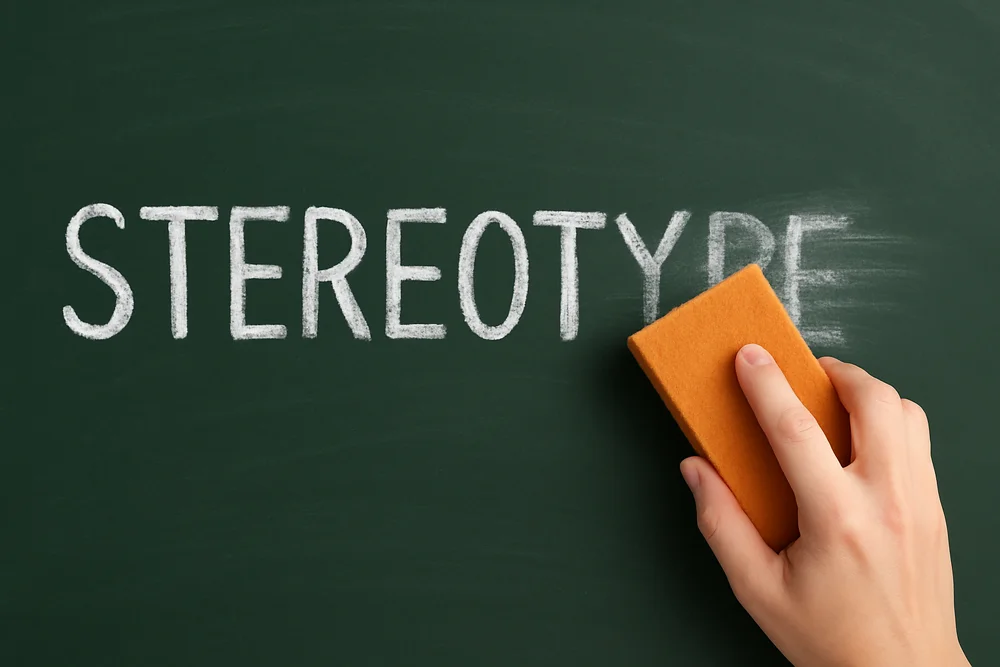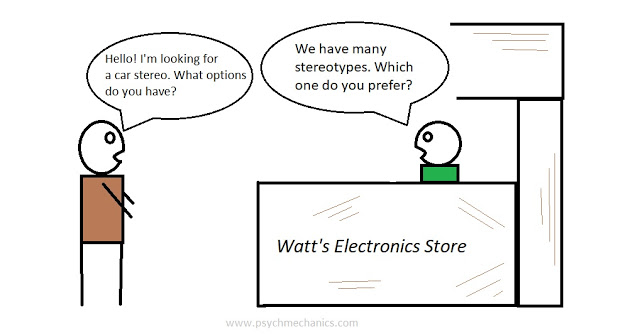Stereotyping means attributing a personality trait or a set of personality traits to a group of people. These traits may either be positive or negative, and stereotyping of groups is usually done based on:
- Age
- Gender
- Race
- Region
- Religion
- Other qualities (beliefs, opinions, preferences, etc.)
For example, “Men are aggressive” is a stereotype based on gender, while “Italians are friendly” is a stereotype based on region.

Stereotype = learned belief
At its core, a stereotype is a learned or acquired belief about a group of people. We acquire stereotypes from the culture in which we live and the information we’re exposed to. Not only are stereotypes learned unconsciously, but stereotyping also occurs unconsciously.1Nelson, T. D. (2006). The psychology of prejudice. Pearson Allyn and Bacon.
Even if you may consider yourself free from any stereotypes, you’ll still stereotype people unconsciously. It’s an inescapable feature of human nature.
To test the degree of unconscious stereotyping in people, scientists use what’s known as the ‘Implicit Association Test’. The test involves showing subjects images quickly and gauging their response to determine what associations they hold in their minds before they have time to think and react in more conscious and politically correct ways.
It’s these association tests that have revealed that even people who consciously think they don’t stereotype are prone to unconscious stereotyping.

Formation of stereotypes
Why is stereotyping such a pervasive feature of human psychology? To answer this question, we go back to the Palaeolithic environments in which most of our psychological mechanisms evolved.
Humans at the time organized themselves into nomadic groups, with approximately 150-200 members in each group. They didn’t have to keep track of a large number of people. They only had to remember the names and personality traits of around 150-200 people.
Today, the societies in which people live have populations that are exponentially larger than those of ancient times. One would expect that humans should now be able to remember the names and traits of many more people.
But this hasn’t happened. People don’t remember more names simply because they live in larger societies. The number of people a person remembers by name still correlates with what was expected of them during the Palaeolithic times.2Bridgeman, B. (2003). Psychology and evolution: The origins of mind. Sage.
So, how do you go about identifying and understanding the vast number of people who live in the world today?
You identify and understand them by categorizing them. Anyone who has studied statistics knows that inordinate amounts of data can be better dealt with by organizing and categorizing it. Stereotyping is nothing but categorizing. You treat groups of people as individuals. You categorize and attribute traits to groups of people based on their country, race, region, sex, etc.
Stereotyping = cognitive efficiency
Stereotyping is thus a way to efficiently understand a large number of people by dividing them into groups. The “Women are emotional” stereotype gives you knowledge about half of the human population, so you don’t have to survey or study every single woman on the planet. Similarly, “Blacks are hostile” is a stereotype that lets you know that there’s a group of people with a non-friendly predisposition.
As you can see, stereotyping is generalizing, and it can blind you to the fact that a significant number of people within the stereotyped group may not fit the stereotype. In other words, you don’t consider the possibility that “All women are not emotional” or “Every black person is not hostile.”
Stereotypes are there for a reason
Stereotypes often contain a kernel of truth. If they didn’t, they wouldn’t get formed in the first place. For instance, the reason we don’t come across stereotypes such as “Men are emotional” is that men, on average and unlike women, are good at hiding their emotions.
The point is that stereotypes are not born out of thin air. They have good reasons to exist. At the same time, not all individuals in the stereotyped group will necessarily possess the traits associated with the group. So when you stereotype someone, the odds that you’re right and wrong are both there. Both possibilities exist.
Us vs Them
Perhaps the most important function of stereotyping is that it helps us differentiate between friend and foe. Typically, people within one’s social group are likely to be perceived favorably, while outgroups are likely to be perceived unfavorably.
This not only helps us feel good about ourselves and our group identity but also enables us to denigrate and sometimes even dehumanize outgroups. Negative stereotyping of outgroups has been a feature of human conflict throughout history.
Also, negative stereotyping is more powerful than positive stereotyping. Neuroscience studies show that our brains respond more strongly to information about groups portrayed unfavourably.3Spiers, H. J., Love, B. C., Le Pelley, M. E., Gibb, C. E., & Murphy, R. A. (2017). Anterior temporal lobe tracks the formation of prejudice. Journal of cognitive neuroscience, 29(3), 530-544.
To our hunter-gatherer ancestors, not being able to differentiate friend from foe could’ve easily meant death.
How stereotypes get broken
Stereotyping is learning by association. It works in the same way as all other beliefs. If you’re exposed to only one type of association, you’ll solidify it over time. If you’re exposed to contradictory associations, there’s a chance you’ll break the stereotype.
For instance, if you previously believed that “Africans are ignorant people” then watching Africans succeed on intellectual fronts could serve to break your stereotype.
However, not everyone has an equal ability to break free from stereotypes. People with higher cognitive abilities (such as pattern detection) are more likely to learn as well as break free from stereotypes on exposure to new information.4Lick, D. J., Alter, A. L., & Freeman, J. B. (2018). Superior pattern detectors efficiently learn, activate, apply, and update social stereotypes. Journal of Experimental Psychology: General, 147(2), 209. In other words, smartness is required to learn and unlearn stereotypes, just as it is required to learn and unlearn all else.
